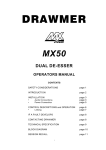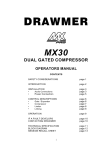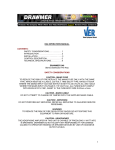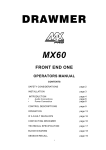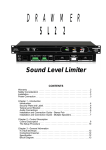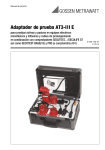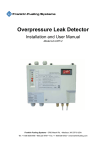Download Drawmer MX50 Specifications
Transcript
Drawmer - MX50 Manual 1 of 6 http://www.drawmer.com/opmx50.htm Back to Operator Manual Index MX50 OPERATORS MANUAL CONTENTS: SAFETY CONSIDERATIONS INTRODUCTION INSTALLATION CONTROL DESCRIPTION OPERATION TECHNICAL SPECIFICATIONS DRAWMER MX50 Dual De-Esser SAFETY CONSIDERATIONS CAUTION - MAINS FUSE TO REDUCE THE RISK OF FIRE REPLACE THE MAINS FUSE ONLY WITH THE SAME TYPE, WHICH MUST BE A CLASS 3, 230 VOLT, TIME DELAY TYPE, RATED AT 63mA WHERE THE MAINS INPUT VOLTAGE SWITCH IS SET TO 230 VOLTS AC. AND 120mA WHERE THE MAINS INPUT VOLTAGE IS 115 VOLTS AC. ALL FUSES MUST COMPLY WITH BS EN 60127-2:1991, SHEET III. THE FUSE BODY SIZE IS 20mm x 5mm. CAUTION - MAINS CABLE DO NOT ATTEMPT TO CHANGE OR TAMPER WITH THE SUPPLIED MAINS CABLE. CAUTION - SERVICING DO NOT PERFORM ANY SERVICING. REFER ALL SERVICING TO QUALIFIED SERVICE PERSONNEL. WARNING TO REDUCE THE RISK OF FIRE OR ELECTRIC SHOCK DO NOT EXPOSE THIS EQUIPMENT TO RAIN OR MOISTURE. CONTENTS INTRODUCTION The MX50 is a highly flexible but compact dual De-Esser designed to fulfil the needs of professional studio, theatre and live sound applications. It may be used in balanced systems at +4dBu operating levels using the XLR connectors, or unbalanced at -10dBu using the TRS stereo jacks. The human voice is one of the most diverse signals ever encountered by engineers 1/31/2005 2:44 PM Drawmer - MX50 Manual 2 of 6 http://www.drawmer.com/opmx50.htm because it contains large variations in signal level and tonal structure. Level variations usually require the services of a compressor, which when properly set, keeps the signal levels within a manageable range. Equalisation is also applied to the signal before or after compression, to compensate for individual styles of voice and also help to add prominence to the signal. For example a person with a soft, mellow voice would probably need both low and high frequencies to be boosted to add body and definition. Unfortunately, in many cases, although the signal sounds just right, sibilants sounds (S's and T's) cause overload due to the EQ which was applied. If some sort of compromise is to be avoided, some form of De-essing is the best solution. This can take the form of equalisation applied to the side-chain of a compressor, so that the compressor reduces the overall signal level in response to high frequency signals only. Although reasonable results can be obtained in this way, a dedicated De-esser is the best solution. In its basic form, a De-esser is a Limiter with a fast release time which reduces the signal level in response to a precise band of frequencies and then recovers quickly. The upper cutoff frequency is generally 8kHz and the lower cutoff is variable from 800Hz to 8kHz. This allows the user to select the correct frequency band for the vocal being processed. The MX50 uses this basic configuration with extra features to give ease of control with total flexibility. It uses a floating threshold to avoid constant adjustment, so the amount of De-essing is set via a single control and is independent of signal levels over a 60dB range. Although De-essers are most often used with the human voice, there are other instances where a De-esser is a valuable asset to an engineer: setting the frequency to the resonant overtones of an acoustic guitar can help to automatically balance the level for recording; similarly, the often too harsh crash cymbals could be De-Middled' by suitably adjusting the frequency control. Users in doubt of when and when not to use the MX50 De-Esser could try this old war-time radio distortion check, using a microphone channel (with suitable gain) patched into the MX50 input: The test goes: " Possesses' possesses more esses than any other word possesses, except uselessness', which possesses as many esses as possesses' possesses." CONTENTS INSTALLATION The MX50 is designed for standard 19" rack mounting and occupies 1U of rack space. Avoid mounting the unit directly above power amplifiers or power supplies that radiate significant amounts of heat. Always connect the mains earth to the unit. Use fibre or plastic washers to prevent the front panel becoming marked by the mounting bolts. AUDIO CONNECTIONS Input and Output connections are provided for use at +4dBu via balanced XLRs or at -10dBu via unbalanced jacks. It is permissible to use both +4dBu and -10dBu outputs simultaneously. If unbalanced operation at +4dBu is required, simply connect the unused terminal to Ground inside the XLR cable plugs. This applies to both inputs and outputs. The wiring convention for XLR being: pin 1 Ground, pin 2 Hot and pin 3 Cold. For use with unbalanced systems, the Cold pin 3 must be grounded at both input and output XLRs. INTERFERENCE If the unit is to be used where it maybe exposed to high levels of disturbance such as found close to a TV or radio transmitter, we suggest that the unit be operated using the XLR connectors. The screens of the signal cables should be connected 1/31/2005 2:44 PM Drawmer - MX50 Manual 3 of 6 http://www.drawmer.com/opmx50.htm to the chassis connection on the XLR connector as opposed to connecting to pin1. The MX50 fully conforms to the EMC standards. GROUND LOOPS If ground loop problems are encountered, never disconnect the mains earth, but instead, try disconnecting the signal screen on one end of each of the cables connecting the outputs of the MX50 to the patchbay. If such measures are necessary, balanced (XLR) operation is recommended. LEVEL CONVERSION It is possible to apply an input to the MX50 at only one of the two possible levels, say -10dB via the jack socket, and utilise both of the output levels and cable options of -10dB and +4dB simultaneously. One useful example of this connection option would be if the unit was used to process a keyboard - commonly these have an output level of -10dB, and are terminated with jack sockets. It is feasible using the MX50s dual output capability to use the -10dB jack input to feed from the keyboard and the -10dB output onwards to the amplifier, and the +4dB balanced XLR connector for a direct feed to the mixing console. This removes the need for any DI box or cable splitter. In this example, ground loop considerations may be required. CONTENTS POWER CONNECTION The MX50 unit will have been supplied with a power cable suitable for domestic power outlets in your country. For your own safety it is important that you use this cable to connect to the mains supply earth. The cable should not be tampered with or modified. The internal fuse fitted to the power supply should never blow under normal operation. If the fuse is suspected of having blown, then a fault will have occurred and this fault condition MUST be inspected by a qualified service engineer. Under NO circumstances should this fuse be replaced by yourself. Always comply with the Safety Instructions. If, for some reason, the unit is to be operated at a mains input voltage which is different to that as supplied, the following procedure must be carried out by a qualified technical engineer. If the voltage change process is to be repeated often, a simple switch can be fitted to simplify this procedure, this part (item # 7026) is available via your Drawmer dealer. 1: Disconnect the unit from the mains. 2: Using a number 1 size pozidrive screwdriver, remove the seven self-tapping screws that retain the top cover. (Two screws are found along each side; two along the top edge at the rear; and the upper screw on the front facia panel). 3: Remove the power supply unit (PSU) module by removing the four pozidrive screws: two longer screws (10mm) holding the mains input connector; two shorter (6mm) along the bottom printed circuit board edge. For conversion to 115Volt AC (previously set to 230Volt AC) 4a: De-solder and remove the single link marked K1. 1/31/2005 2:44 PM Drawmer - MX50 Manual 4 of 6 http://www.drawmer.com/opmx50.htm Fit two links in the positions K2 and K3. 5a Exchange the 125mA fuse for a similar type rated at 63mA. For conversion to 230Volt AC (previously set to 115Volt AC) 4b: De-solder and remove the two links marked K2 and K3. Fit a single link in the position K1. 5b Exchange the 63mA fuse for a similar type rated at 125mA.In both cases: 6: Replace the power supply using the four screws. 7: Ensure the jumper connector (P2) is correctly aligned. 8: Replace the top cover using the seven screws. CONTENTS CONTROL DESCRIPTION Both channels of the MX50 are identical and may be used completely independently or linked for stereo operation. In the linked mode, only the left-hand channel controls are functional and serve as master controls, though the channel bypass switches remain independent. In linked mode, both de-essers of the two channels track together to avoid the inevitable image shifting that would occur if the stereo signal were treated independently. FREQUENCY Variable frequency from 800Hz to 8kHz covers the full sibilant range, including hard sounding harmonics and other side effects which can be generated when treble frequencies are boosted or enhanced in some way to brighten lower frequencies. This control should be set to the same frequency - or centre of the unwanted frequencies - as the esses' in the signal being processed. DE-ESS This rotary should be treated as a more' control. It determines how much gain reduction is applied at the chosen frequency, up to a maximum of 20dB, which could be very noticeable in broadband mixes. NOTE: that this control uses floating threshold circuitry which removes the need for a De-Ess Threshold. So, during a quiet passage, the sibilants will be held to a level which matches the quieter original signal. GR DISPLAY When the signal peaks are close to that of the Frequency control, the amount of gain reduction taking place will be displayed on the LED meter: governed by the position of the De-Ess control. AIR The AIR switch allows frequencies above the sibilant band to be retained during De-Essing, thus preserving upper harmonics and increasing the transparency of operation. Normally we would recommend leaving this switch depressed (In). De-Ess Band FULL Full band operation will reduce the total signal level in response to signals in the selected frequency band. This mode of operation will produce less phase shifting of broadband material and single vocals. SPLIT Split band operation will only reduce the selected frequencies of the processed signal, leaving lower frequencies as they were. This is particularly useful for 1/31/2005 2:44 PM Drawmer - MX50 Manual 5 of 6 http://www.drawmer.com/opmx50.htm reducing string noise on guitars, breath noise on flute, or composite material. BYPASS The Bypass position routes the input signal to the output with no processing. These switches are independent of any linking and will only bypass their respective channel. Link Depressing this switch configures the unit in stereo mode where the average left/right signal level is used as the floating threshold. The two individual channels must still be set up as in mono operation. Usually they will be set the same, but in some circumstances, it may be necessary to have different settings. In linked mode, the red status LED beneath the Link switch will be illuminated. see linked operation CONTENTS OPERATION The unit should be connected in line with the signal to be processed via suitable insert points. Ensure that the insert send and return level on your console matches the MX50 input/output sockets that are being used. The MX50 has just two rotary controls and two push button switches per channel, with a link switch in the centre, for processing stereo material. We recommend that you try all the control options with some test material, so that the full potential of the MX50 is explored. Start with the controls set as follows:Frequency -- Clockwise at 8kHz De-Ess-- Anticlockwise Air -- Out Band -- Full Bypass -- Out Process some sibilant material and increase the De-ess control. You will notice that frequencies around 8kHz produce reductions in signal level. This can be viewed using the G.R display. Then reduce the frequency and notice that progressively lower frequencies cause larger amounts of gain reduction. The combination of Frequency and De-ess should give the required reduction in sibilant levels. Generally, the narrower the frequency band, the more De-ess will be required to produce the same audible gain reduction. There are two possible problems with the above setup, depending on the kind of source material being processed. On a mixed signal, frequencies above and below the De-ess band are also attenuated. This may be desirable for a single vocal, but when processing a mix, it is better to attenuate only the high frequencies, so switching to Split Band is recommended. Notice that low frequencies are not affected by the activities of the de-esser, resulting in a more transparent sound. The extreme high frequencies are still attenuated with the sibilants. Once again, this may be desirable if the sibilants have high levels of signals above 8kHz. More usually however, the sibilants are within the normal range and the extreme highs require less attenuation. In these cases, the AIR switch should be used. This leaves signals above 8kHz un-processed, thus retaining the original HF detail. The practical effect of this switch is to preserve all upper harmonics of sibilants whilst 1/31/2005 2:44 PM Drawmer - MX50 Manual 6 of 6 http://www.drawmer.com/opmx50.htm reducing the sibilants themselves. For the most transparent processing and general purpose use, we suggest split band as the first choice, together with AIR. CONTENTS LINKED OPERATION User convenience usually dictates that stereo operation is via Channel 1, so that only one set of controls have to be adjusted. This is particularly true of compressors, where image shifting is to be avoided. In the case of the MX50 however, this would restrict the units stereo potential, so both channels must be adjusted separately. The reason for this is the nature of stereo material. High frequencies are more likely to occupy the full stereo image because they are present for less time and have less effect on the stereo image, so high frequency activity on, say the left channel may not be present on the right, so it would be unwise to attenuate the right channel in response to a signal on the left. Each De-esser channel has a floating threshold, which is based on the full band signal level of that channel. These internal signals are linked to produce a mono signal level which is used to control the thresholds of both channels. The result is that sibilants are limited to the stereo level rather than the individual channel level. The benefit of individual channel operation is when sibilant frequencies are different on each channel. In these cases, the individual channel frequency as well as the other parameters can be adjusted to suit that channel. Of course, abuse of this freedom can cause image shifting, so we would suggest that the two channels are set similarly, unless special effects are being created. CONTENTS MX50 TECHNICAL SPECIFICATIONS (Measurements taken using +4dBu balanced XLR input where applicable) INPUT IMPEDANCE 20K Ohms (bal), 20K Ohms (unbal) MAXIMUM INPUT LEVEL +21dBu INPUT CMR > -40dB OUTPUT IMPEDANCE 50 Ohms (bal), 100 Ohms (unbal) MAXIMUM OUTPUT LEVEL +21dBu BANDWIDTH 12Hz to 51KHz -1dB CROSSTALK @ 35KHz -98dB @ 1KHz below noise level NOISE AV Wideband (worst case) -99dB 22Hz - 22KHz -95dB DISTORTION Typical Input 100Hz Unity Gain, +4dBu input <0.03% +14dBu input, 10dB Gain Red <0.2% 1KHz <0.02% <0.2% 10KHz <0.03% <0.2% POWER REQUIREMENTS 115Volt or 230Volt at 50-60Hz, 9 Watts FUSE RATING T32mA for 230Volt, T63mA for 115Volt CONFORMING TO BS EN 60127-2:1991 SHEET III FUSE TYPE 20mm x 5mm, Class 3 Slo-Blo, 250Volt working CASE SIZE 482mm (w) x 44mm (h) x 200mm (d) WEIGHT (incl packaging) 3.2 Kgs 1/31/2005 2:44 PM






